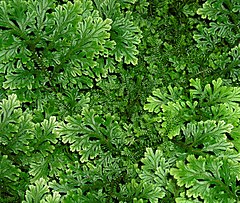Spikemosses
| Spikemoss | |
|---|---|
 |
|
| Scientific classification | |
| Kingdom: | Plantae |
| Division: | Lycopodiophyta |
| Class: | Lycopodiopsida |
| Order: | Selaginellales |
| Family: | Selaginellaceae |
| Genus: |
Selaginella P. Beauv. |
| Species | |
|
See text. |
|
See text.
Selaginella is the sole genus of vascular plants in the family Selaginellaceae, the spikemosses or lesser clubmosses. This family is distinguished from Lycopodiaceae (the clubmosses) by having scale-leaves bearing a ligule and by having spores of two types. They are sometimes included in an informal paraphyletic group called the "fern allies". S. moellendorffii is an important model organism. Its genome has been sequenced by the United States Department of Energy's Joint Genome Institute. The name Selaginella was erected by Palisot de Beauvois solely for the species Selaginella selaginoides, which turns out (with the closely related Selaginella deflexa) to be a clade that is sister to all other Selaginellas, so any definitive subdivision of the species leaves two taxa in Selaginella, with the hundreds of other species in new or resurrected genera.
Selaginella species are creeping or ascendant plants with simple, scale-like leaves (microphylls) on branching stems from which roots also arise. The stems are aerial, horizontally creeping on the substratum (as in Selaginella kraussiana)sub erect (Selaginella trachyphylla)or erect(as in Selaginella erythropus). The vascular steles are polystelic protosteles. stem section shows the presence of more than two protosteles. Each stele is made up of diarch and exarch xylem in centre. The steles are connected with the cortex by means of many tube-like structures called trabeculae, which are modified endodermal cells with casparian strips on their lateral walls. The stems contain no pith.
...
Wikipedia
